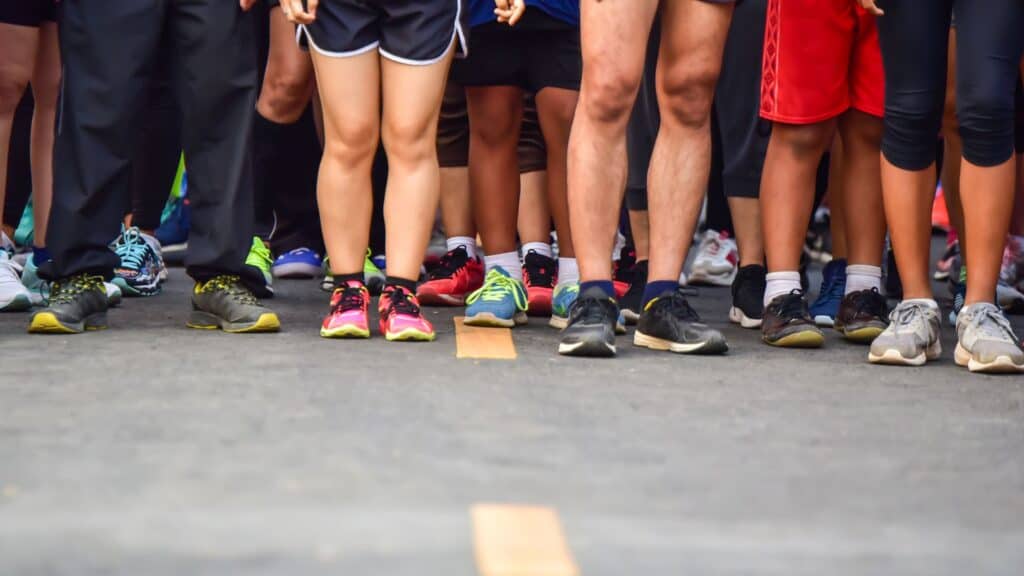Imagine the thrill of running in the prestigious Boston Marathon, an event that takes place every year on the third Monday of April. It’s unlike any other marathon in the world, as it requires participants to achieve a qualifying time.
This means that only those who meet the time standards based on their gender and age can take part. For many passionate runners, earning a spot in the Boston Marathon is a lifelong aspiration.
If you’re aiming to qualify for the Boston Marathon, this blog post highlights the 10 best marathons not many know about that can help you achieve your goal.

First – What Are the Boston Marathon Qualifying Times?
Qualifying for the Boston Marathon is no small feat.
To ensure fairness and competitiveness, the Boston Athletic Association (B.A.A.) sets specific qualifying time standards for each age group.
These standards vary based on age and gender, reflecting the diverse range of participants. Let’s dive into the qualifying times across different age brackets.
| Age Group | MEN | WOMEN |
| 18-34 | 3hrs 00 min 00sec | 3hrs 30 min 00sec |
| 35-39 | 3hrs 05 min 00sec | 3hrs 35 min 00sec |
| 40-44 | 3hrs 10 min 00sec | 3hrs 40 min 00sec |
| 45-49 | 3hrs 20 min 00sec | 3hrs 50 min 00sec |
| 50-54 | 3hrs 25 min 00sec | 3hrs 55 min 00sec |
| 50-54 | 3hrs 25 min 00sec | 3hrs 55 min 00sec |
| 55-59 | 3hrs 35 min 00sec | 4hrs 05 min 00sec |
| 60-64 | 3hrs 50 min 00sec | 4hrs 20 min 00sec |
| 65-69 | 4hrs 05 min 00sec | 4hrs 35 min 00sec |
| 70-74 | 4hrs 20 min 00sec | 4hrs 50 min 00sec |
| 75-79 | 4hrs 35 min 00sec | 5hrs 05 min 00sec |
| 80 and over | 4hrs 50 min 00sec | 5hrs 20 min 00sec |
Now that you know the time you have to beat, let’s look at these lesser-known marathons that’ll help you qualify for the Boston Marathon.
The criteria for the best BQ that we are looking at to make up this list is that the marathon needs to be fast and at a low altitude.
10 Of The Fastest Marathons To Qualify For The Boston Marathon
- Grandma’s Marathon
- Ottawa Marathon
- REVEL Big Cottonwood Marathon
- Chevron Houston Marathon
- Jack and Jill’s Downhill Marathon
- Bayshore Marathon
- Sugarloaf Marathon
- Eugene Marathon
- Vancouver Marathon
- Light At The End Of The Tunnel Marathon
10 Best Boston Qualifying Marathons That No One Knows About (In no particular order)
Location: Duluth, Minnesota, USA
Next Date of Race: Mid-June
Finishers: 7,182
Boston Qualifiers: 1,462
Grandma’s Marathon takes participants along the picturesque North Shore of Lake Superior. The course begins in Two Harbors and follows a mostly flat and scenic route, showcasing breathtaking views of the lake and the surrounding forested areas.
With its gentle elevation changes and supportive atmosphere, Grandma’s Marathon is known for its runner-friendly course.
Location: Ottawa, Ontario, Canada
Next Date of Race: End of May
Finishers: 2,431
Boston Qualifiers: 342
The Ottawa Marathon course begins in the heart of downtown Ottawa and takes runners on an exciting journey through the city’s iconic landmarks.
Then crosses the river into Quebec, passing through the vibrant city of Hull. Runners then make their way back to Ottawa, where they venture through the prestigious neighborhood of Rockcliffe before returning downtown.
The course continues south, crossing the river once again, and eventually loops back north alongside the scenic Rideau Canal.
This diverse and captivating route showcases the beauty and rich history of both Ottawa and Quebec, providing an unforgettable marathon experience.
Location: Salt Lake City, Utah, USA
Next Date of Race: Beginning of September
Finishers: 1,516
Boston Qualifiers: 555
The REVEL Big Cottonwood Marathon offers a breathtaking downhill course set against the backdrop of the Wasatch Mountains.
Starting in the scenic Big Cottonwood Canyon, runners descend over 4,000 feet to the finish line in Cottonwood Heights.
The course is known for its fast and picturesque route, offering participants a chance to achieve Boston qualifying times.

Location: Houston, Texas, United States
Next Date of Race: Third Sunday in January
Finishers: 6,105
Boston Qualifiers: 945
The Chevron Houston Marathon is an iconic annual marathon attracting thousands of participants from around the world.
Known for its fast and flat course, the marathon offers runners a chance to achieve personal best times and qualify for the Boston Marathon.
The course takes runners through the neighborhoods of Houston, showcasing the city’s unique culture and architecture.
Participants start downtown and navigate a scenic route that passes through landmarks such as the Museum District, Rice University, and Memorial Park.
Location: North Bend to Rattlesnake Lake, Washington, USA
Next Date of Race: End of July
Finishers: 761
Boston Qualifiers: 175
Jack and Jill’s Downhill Marathon is known for its breathtaking and fast course that starts in the mountains of North Bend and descends to Rattlesnake Lake.
The route offers stunning views of lush forests, mountain peaks, and the scenic Snoqualmie River.
With a significant net downhill, this race provides an excellent opportunity to achieve a Boston Marathon qualifying time.
Location: Traverse City, Michigan, USA
Next Date of Race: Memorial Day Weekend
Finishers: 1,366
Boston Qualifiers: 288
The Bayshore Marathon takes runners on a scenic journey along the picturesque shores of Lake Michigan in Traverse City.
Known for its speed, the Bayshore Marathon is considered one of the fastest spring marathons available.
The full marathon begins on the grounds of Northwestern Michigan College and winds its way along the waterfront, hugging the East Arm of Grand Traverse Bay.
The course is predominantly flat, 100% paved, and provides refreshing shade along much of the route.
Location: Carrabassett Valley, Maine, USA
Next Date of Race: Mid-May
Finishers: 504
Boston Qualifiers: 153
The Sugarloaf Marathon presents a captivating and demanding course that guides runners through the picturesque landscapes of western Maine.
From its starting point at Sugarloaf Mountain to the exhilarating finish, this route treats participants to awe-inspiring mountain vistas, undulating hills, and the serene beauty of the Carrabassett River.
With its diverse terrain and elevation changes, this race provides a prime opportunity to put your endurance and determination to the test.
The first 5 miles of the point-to-point Sugarloaf Marathon course offer a flat stretch that allows runners to establish their rhythm and pace.
As the race progresses, miles 5 to 10 present rolling hills, providing an invigorating challenge for participants. Notably, at mile 8, runners encounter a steady two-mile climb that demands both physical and mental strength.
However, the final stretch of the course, spanning the last 16 miles, offers a thrilling downhill descent, allowing runners to unleash their speed and revel in the exhilaration of the race.
The Sugarloaf Marathon is not just a race; it is a chance to immerse yourself in the enchanting landscapes of western Maine, challenge your limits, and celebrate the beauty of the Carrabassett River and the surrounding countryside.
Location: Eugene, Oregon, USA
Next Date of Race: Last Sunday of April
Finishers: 2,038
Boston Qualifiers: 468
Renowned as “Track Town, USA,” Eugene has a storied history in track and field, making it a fitting location for this iconic marathon.
The marathon course typically winds through picturesque routes that highlight the natural beauty of the area, including scenic parks, tree-lined streets, and charming neighborhoods.
The elevation of the Eugene Marathon course is generally considered to be relatively flat and fast. While the specific elevation profile may vary slightly from year to year due to potential course adjustments, the organizers typically design the route to be conducive to achieving personal best times.
Location: Vancouver, British Columbia
Next Date of Race: First Sunday of May
Finishers: 4,918
Boston Qualifiers: 406
The race attracts participants from around the world, who run through the city’s iconic landmarks.
With its scenic route that showcases the natural beauty of the area, the marathon provides a memorable experience for both runners and spectators.
The course is designed to be relatively flat, making it favorable for achieving fast times.
Location: Washington State, USA
Next Date of Race: Beginning of June
Finishers: 757
Boston Qualifiers: 297
The Light at the End of the Tunnel Marathon is not only renowned for its unique route through the Snoqualmie Pass tunnel and the captivating scenery of the Cascade Mountains but also its significant downhill course.
The marathon is known as one of the fastest courses in the United States due to its gradual downhill slope.

Now that you are aware of the races that can help you BQ and the target time you need to achieve, you may find yourself pondering, “What steps should I take to achieve my BQ, and how can I make it happen?”
I have put together a few tips and strategies to help you improve your running speed.
Let’s dive in…
How Can I Improve My Speed and Decrease My Race Times?
When it comes to the Boston Marathon, speed is of paramount importance.
To achieve your best race time and qualify for this prestigious event, you need to focus on strategic training techniques and fine-tune your running performance.
Here are some effective strategies that can help you improve your speed and cut those valuable seconds off your qualifying time:
- Incorporating Interval Training,
- Adding Strength Training,
- Gradually Increasing Your Mileage
- Cross-Train
- Hydrate & Fuel
- Get Enough Rest and Recovery
Incorporating Interval Training
If you’re looking to boost your running speed, interval training is where it’s at!
It’s a fantastic method that involves alternating between intense running and periods of rest or lower-intensity activity.
Now, before you dive headfirst into interval training, it’s important to have a solid running foundation.
Take some time to establish a consistent running routine that you feel comfortable with. Once you’ve got that down, you can start sprinkling shorter intervals into your workouts.
For instance, try sprinting for about 30 seconds and then giving yourself a breather with 1–2 minutes of rest or a light jog.
But here’s the key: don’t feel like you have to go all-out during each interval. Start gradually and let your body adjust. Over time, you can gradually increase the length and intensity of your intervals.
The important thing is to listen to your body and avoid pushing yourself too hard, especially if you’re new to running.
Adding Strength Training
Strength training is an absolute game-changer for runners aiming to up their performance and stay injury-free. One of the most significant advantages is injury prevention.
By ensuring the correct function of smaller muscle groups, strength training helps stabilize your body and avoids larger muscles taking over, leading to misalignment and potential injuries.
Not only that, but strength training also boosts a runner’s economy by a notable 4%–6%, depending on factors like training level and the type and frequency of strength workouts.
This means you’ll be able to go further and with greater efficiency, using less energy in the process. Plus, it helps stave off fatigue, keeping you going strong.
When it comes to incorporating strength training into your routine, aiming for two to three sessions per week is ideal. I know it might feel like there’s not enough time, but trust me, it’s worth it for injury prevention and performance enhancement.
And don’t forget about periodization! Balancing your strength training with your running regimen is key. It’s all about building a solid foundation and complementing your overall training plan.
Check out this video, where we share with you an insanely simple, 5-exercise routine that every busy runner should incorporate into their training.
It’s a game-changer for those who are constantly on the go but still want to boost their running performance.
Exercises like toe raise and forward & lateral band walks, for example, are perfect. Our free strength training plan is a great place to start and you can download it by clicking here.
Gradually Increasing Your Mileage
Here’s a valuable tip to enhance your running speed and endurance: gradually increase your mileage.
Building up your distance slowly and sticking to a maximum 10% weekly increase is a smart move to avoid injuries. Remember, consistency is key!
You need to ensure easy runs are easy and that you DO NOT run hard on easy days to ensure proper aerobic development.
Don’t underestimate the power of walking breaks! Introducing short walk breaks into your running sessions can help you sustain your mileage over time.
It’s a smart way to give your body a breather while still making progress.
Cross-Train
Incorporating cross-training into your training plan is a game-changer for your Boston Marathon preparation.
It’s a key element that adds variety to your workouts and helps minimize the strain on your body.
While running focuses on high-impact movements, cross-training allows you to engage in activities that provide cardiovascular benefits and load your muscles without subjecting them to excessive stress.
So, what are some fantastic cross-training options to consider? Here are a few that can complement your running routine and give you that extra edge:
1. Cycling: Hop on a bike and enjoy a low-impact, yet highly effective, cardiovascular workout that strengthens your leg muscles without the pounding of running. (Cycling To Run FASTER: How To Use Your Bike To Become A Better Runner)
2. Swimming: Dive into the pool for a refreshing and joint-friendly workout that engages your entire body, improves cardiovascular fitness, and enhances muscular endurance. (Revealed: How To Swim Your Way To Becoming A Better Runner)
3. Elliptical: Take advantage of this low-impact machine that mimics the natural motion of running without the impact on your joints. It provides a great cardio workout while engaging your upper and lower body muscles.
4. Rowing: Get your heart pumping and build both upper and lower body strength with rowing. This full-body workout helps improve endurance and is a fantastic option for cross-training.
5. Yoga: Enhance your flexibility, core strength, and balance through practicing yoga. It not only complements your running by improving posture and alignment but also promotes mental focus and relaxation.

Hydrate & Fuel
Achieving peak running performance goes beyond training and technique; it requires proper nutrition and hydration to support your body.
To maximize your performance, it’s crucial to provide your body with the right fuel and hydration.
If you’re following a low-carb diet, consider incorporating non-carbohydrate sources like fat into your runs. Additionally, make it a priority to refuel your muscles within the first 30 minutes after exercise to replenish energy stores.
On the flip side, before long runs, plan a high-carb meal consisting of nutrient-dense foods. This will help sustain your energy levels throughout the run.
During your training, it’s essential to experiment with different fuelling options to find what works best for you. If you’re experiencing low energy levels, consider increasing your fuel intake during exercise.
Remember, fuelling during long runs is crucial for maintaining energy levels and preventing muscle fatigue.
Find a balance that works for you and prioritize proper nutrition and hydration to enhance your running performance. Your body will thank you for the fuel it needs to reach new heights!
Get Enough Rest and Recovery
Rest and recovery are vital aspects of optimizing your speed and supporting your body’s adaptation to the demands of running.
To ensure your body receives the necessary rest and recovery, it’s essential to incorporate scheduled rest days into your training plan.
Additionally, engaging in activities that promote recovery, such as foam rolling, stretching, and massage, can be beneficial.
Rest days tend to be underestimated by many runners, but they are integral to any training plan. They provide a valuable opportunity for our bodies to adapt and progress based on the completed training.
Without sufficient recovery, we risk compromising the full benefits of our training efforts.
Giving yourself time to recover after runs is crucial for returning stronger and better prepared for your next session.
Prioritizing rest and recovery is just as important as focusing on your training sessions.
Research even suggests that chocolate milk can be a cost-effective and beneficial alternative to expensive recovery products, as it can extend training exhaustion time and aid in muscle repair.
For more insights and a detailed discussion on the topic, you can watch our video “Is Chocolate Milk A Great Recovery Drink For Runners?” where we delve into the scientific aspects and explore the study further.
Neglecting recovery increases the risk of injury and illness and hampers overall performance. When we exercise, we cause minor damage to our system. Recovery is the phase when the body repairs this damage and makes improvements, enabling us to handle more load in subsequent exercises.
These incremental improvements contribute to enhanced fitness, speed, and strength. Without adequate recovery, we impede the complete repair and compensation necessary for effective training.
Check out this article where we dive into a detailed overview of the Boston Marathon Route, a Mile-by-mile breakdown of the course, & a FREE Boston Marathon GPX file.



Comments are closed.